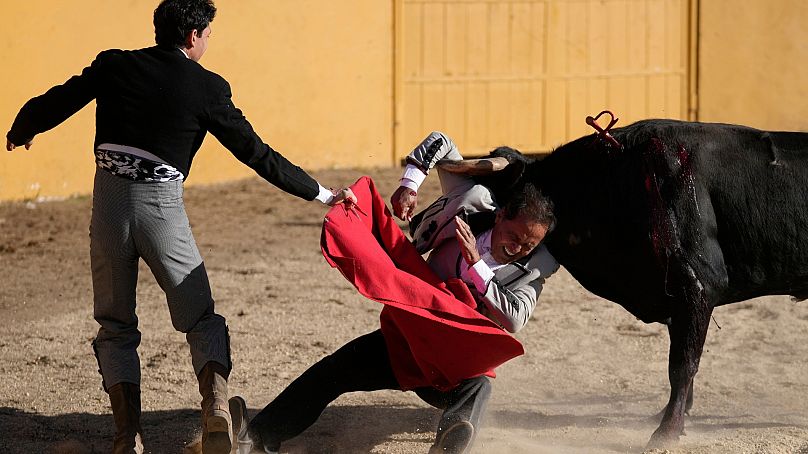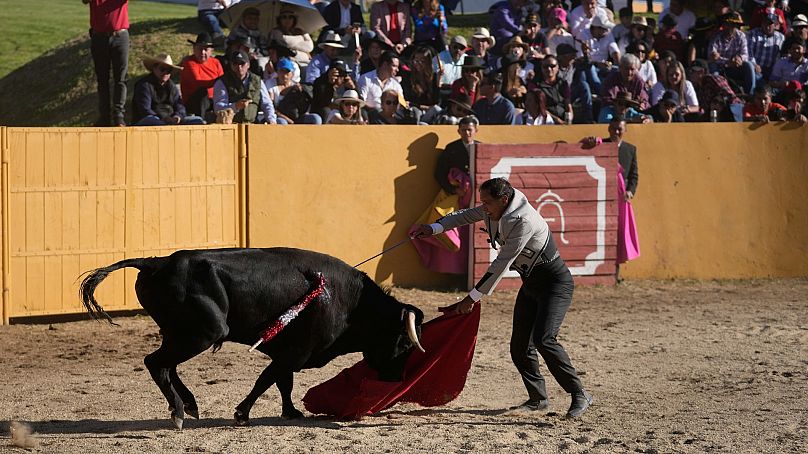
Colombia could soon ban bullfighting. It is one of just eight countries where the practice is still legal.
The tradition has taken some blows around the world in recent years. Courts and municipal governments in cities like Barcelona, Medellin and Mexico City have issued rulings to discourage bullfights due to ethical concerns.
Colombia’s Senate approved a nationwide ban in December. The House of Representatives — which narrowly voted down an earlier ban in November — could take up the latest legislation in coming weeks when it returns from its three-month recess.
It will be a closely followed vote in the country.
Where else is bullfighting still legal?
There are only eight countries throughout the world where bullfighting still takes place — three of which are in Europe.
These include Spain, France, Portugal, Mexico, Colombia, Venezuela, Peru and Ecuador.
Every year, approximately 250,000 bulls are killed in bullfights, according to Humane Society International (HSI).
Bullfighting is already banned by law in many countries including Argentina, Canada, Cuba, Denmark, Italy and the United Kingdom.
Is bullfighting still popular in Europe?
In 2021, 824 bullfighting events took place in Spain, according to Statistica. Prior to the pandemic, the number had been in decline, with around 350 fights in 2019.
Although the practice is deeply ingrained in the country’s tradition and identity, it has faced opposition in recent decades. A 2016 poll by Ipsos, for World Animal Protection, found that 58 per cent of adults in Spain aged 16-65 opposed bullfighting, while 19 per cent supported it.
While still legal in the country, some Spanish cities — such as Calonge, Tossa de Mar, Vilamacolum and La Vajol — have outlawed the practice. Catalan’s 2010 ban was overturned by Spain’s top court in 2016.
In Portugal, 191 bullfights were held in 2022 — a 58 per cent bounceback after a sharp drop during the pandemic. These were attended by 375,200 spectators, according to the Portuguese Bullfighting Federation, ProToiro.
Bulls are not permitted to be killed in the arena in Portugal. If they are badly injured, they may be killed by a professional butcher after the fight. Otherwise they are restored to health.
A 2018 proposal to ban bullfighting in Portugal was overwhelmingly rejected by the country’s parliament.
In France, bullfights only continue in the south near the border with Spain and along the Mediterranean coast. The French National Assembly was due to vote on a proposed ban in November 2022. But the proposal was withdrawn amid rural opposition.
Around 1,000 bulls are killed each year in France, according to the French National Observatory of Bullfighting Cultures.
Nearly 75 per cent of French people are in support of a bullfighting ban, according to an Ifop poll in the newspaper Journal du Dimanche.
Are Colombians supportive of a bullfighting ban?
Bullfights have been held in Colombia since colonial times. In recent years, public sentiment has shifted against the practice over ethical considerations.
“We are talking about living and feeling beings,” says Andrea Padilla, a recently elected senator and longtime animal rights activist who drafted the anti-bullfighting law.
“These are mammals with a nervous system that enables them to feel pain and suffering with the same intensity as humans… and who shouldn’t be exposed to a slow and painful death.”
But supporters of bullfights say the ban would obliterate an art form, deprive rural residents of a popular entertainment, and deny livelihoods to street vendors at bullfights. They also argue that politicians like Padilla are trying to impose their beliefs on others.
“Almost every bovine that has been raised by man ends up in a slaughterhouse,” says bull breeder Gonzalo Sanz de Santamaria.

“But the bull dies in a temple, admired, applauded, showing its bravery and fighting for its life.”
Santamaria is a fourth generation breeder and director of the Cultural Freedom Foundation, a group that supports bullfights, cockfights, rodeos and other traditional events that involve animals.
Santamaria said that for breeders like himself bulls are like “gods” that are bred with utmost care in free range pastures, where they are “admired and venerated”.
Surveys suggest bullfighting aficionados like Santamaria are a small share of Colombia’s population. In a November poll by market researcher Datexco, 85 per cent of Colombians said they agreed with a ban on bullfights, while 13 per cent said they were against plans to ban the tradition.
How would Colombia’s bullfighting ban work?
Padilla’s law proposes banning all bullfights within three years. It also says that bullfights should be adjusted immediately so that the animals aren’t killed in arenas or attacked with pikes and handheld harpoons called banderillas.
Bullfighting aficionados say those measures would effectively end the tradition.
However, in Colombia’s House of Representatives many politicians have been reluctant to vote against bullfights.
In November a bullfighting ban presented by congressman Juan Carlos Losada was rejected by a narrow margin of just three votes. Some lawmakers said they preferred a bill that “moderates” bullfights by making some of the weapons used in these events less invasive.
Still, Senator Padilla and thousands of others in Colombia argue that there is no ethical justification for events where animals are killed for entertainment.
“Any society that wants to advance in non violence, in peace and in respect for life, needs to ban these cruel spectacles,” says Padilla. She adds that her bill directs the government to help create new sources of income for people working in bullfights.
What happens at a bullfight?
At a bullfight, the matador’s assistants first provoke the bull with large colourful capes. The animal is then fought and taunted in three stages that last about six minutes each.
First, a horseman injures the bull with a long pike. Then, assistants rush up to push sharp harpoons into the animal’s upper back. Lastly, the matador stabs the bull between the shoulders with a sword.
Advocates of bullfighting argue that if the matador aims correctly, the animal dies in a matter of seconds. However this is rarely the case, according to HSI, who say the matador often misses the target.
In some parts of Colombia, like the city of Manizales, bullfights still draw thousands of spectators each year. The bullfighting ring in that city is owned by the local chapter of the Red Cross, and the city’s annual bullfighting festival generates thousands of dollars for a children’s hospital.
“It’s sad that people who don’t know anything about our sector want to make laws about us,” says Sergio Alzate, 22, an aspiring matador and pupil at the city’s bullfighting school.
In more remote parts of the country, the tradition survives on a smaller scale.
On a recent Saturday at a hacienda in Colombia’s Andes, six veteran bullfighters performed for free in front of about 150 people.

A 61-year-old matador nicknamed ‘Little gypsy of America’ fell headfirst into the dust when he was head butted by a bull. He recovered to the applause of the crowd, and later killed the bull with a sword thrust to the back of its neck.
The festival was to raise money for a foundation hoping to save the centuries-old tradition from a national ban.
“Colombia’s art and culture must endure,” the matador, Jelain Fresneda, said after the difficult bout. “We need to ensure our freedoms are respected.”
The festival took place in the Andean town of Villapinzon, about a two-hour drive northeast of Bogota.
Some assert that bullfighting constitutes a fair and even fight between the bull and the matador. But the bulls face the stress of transport, and sometimes branding, weakening them mentally and physically before coming face-to-face with the matador, says HSI.
What would happen to the bulls if fights are banned?
Some bullfighting advocates are focused on the future of Colombia’s herd of fighting bulls, whose market value would plummet after a ban, forcing many breeders to sell them to slaughterhouses.
Miguel Aparicio, a businessman who runs a shelter for farm animals outside Bogota says he’s already received eight young bulls from breeders who are downscaling their operations as the number of bullfights in Colombia decreases.
He says that bull breeding farms should consider reinventing themselves as ecotourism sites or sanctuaries for fighting bulls, so that people can enjoy these animals without seeing them killed.
“Just banning bullfights isn’t going to protect the bulls” Aparicio says. “We need to find a solution that looks out for the interests of these animals.”
